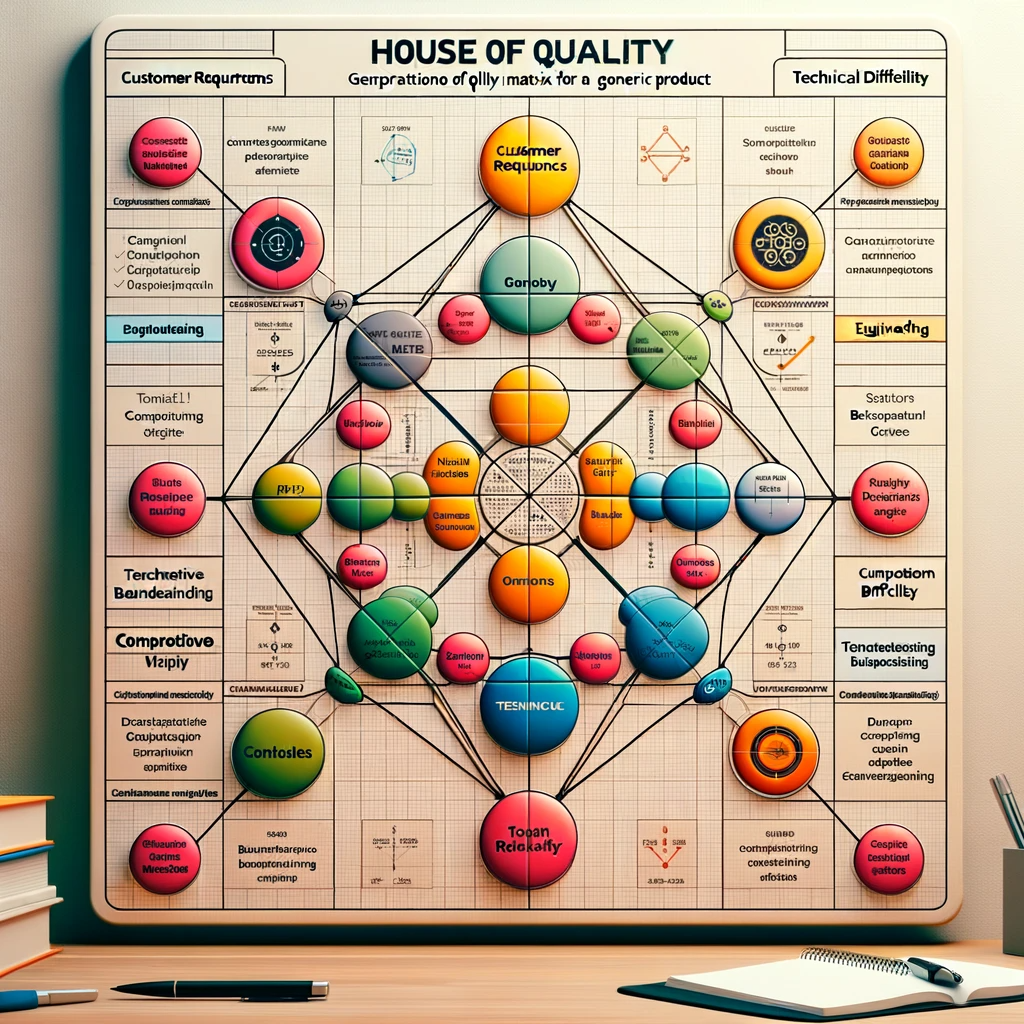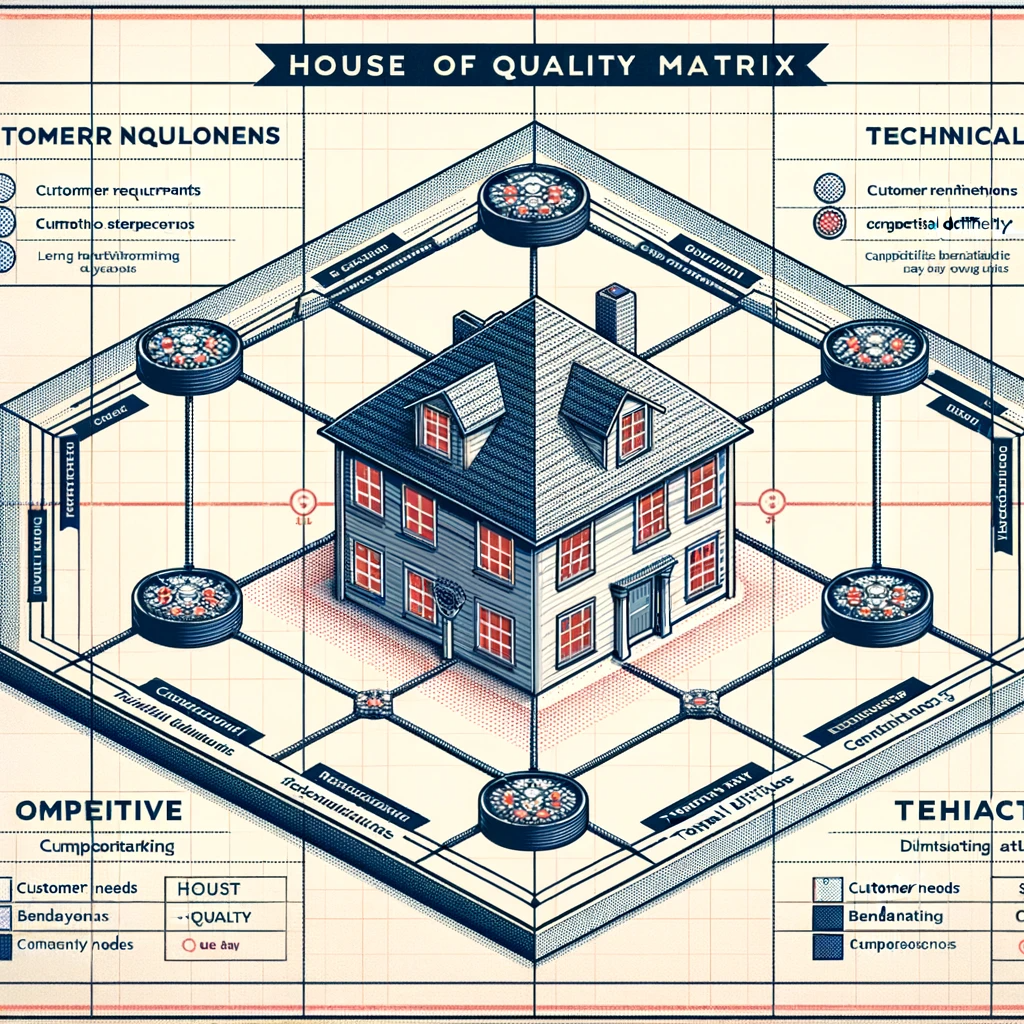Quality Function Deployment (QFD) is a systematic approach used in product and service development that transforms customer needs and expectations into technical requirements. This method prioritizes customer requirements and ensures that they are addressed throughout the product development process. A crucial tool within QFD is the “House of Quality,” a unique diagram that serves as a visual representation of the relationship between customer desires and the company’s capabilities to fulfil these desires.
The House of Quality is a foundational element in product development and customer satisfaction. It bridges the gap between what customers want and what manufacturers can provide, ensuring a product or service aligns with the market’s demands. This intricate matrix not only helps in identifying customer needs but also assists in translating these needs into actionable, technical specifications.
The purpose of this article is to delve into the workings of the House of Quality. We will explore how it operates as a central component in Quality Function Deployment, its structure, and the benefits it brings to product development. By understanding the House of Quality, businesses can better align their strategies and operations with customer needs, leading to enhanced product quality and customer satisfaction.
Origins and Concept of the House of Quality
Origins of the House of Quality
The House of Quality, as an integral part of Quality Function Deployment (QFD), originated in Japan in the late 1960s. It was developed initially by Yoji Akao and Shigeru Mizuno, who sought a method to ensure that customer needs were consistently integrated into product design and development. The adoption of this approach by several Japanese companies, most notably Toyota, led to significant improvements in product quality and customer satisfaction, which eventually garnered global attention.
The Bridge Between Customer Requirements and Company Capabilities
The core function of the House of Quality is to serve as a bridge between customer requirements (often termed “Voice of the Customer”) and the company’s ability to meet these needs. It translates subjective customer desires into objective, quantifiable design targets and technical specifications. This translation ensures that every aspect of the product development process is aligned with what customers want, leading to products that not only meet but often exceed customer expectations.
Structure Resembling a House
The structure of the House of Quality is designed to resemble a house, which is the basis for its name. This metaphorical ‘house’ consists of several components:
- The Foundation (Customer Requirements): At the base of the house are the customer requirements. These are gathered through market research, surveys, and direct customer feedback.
- The Walls (Technical Specifications): The walls represent the technical specifications or how the company plans to meet these customer requirements. It’s where customer needs are translated into measurable design attributes.
- The Roof (Relationship Matrix): The roof of the house is a matrix that shows the relationship between customer requirements and technical specifications. This matrix helps in understanding how well each technical aspect satisfies a particular customer need.
- Supporting Beams (Interrelationships): These are the interactions between different technical specifications, indicating how changes in one aspect might affect another.
- The Rooms (Priority Areas): Within the house, different ‘rooms’ signify priority areas, showing which customer needs are the most critical and how they align with the company’s competencies.
By structuring these elements in a house-like format, the House of Quality allows for a clear visual representation of how customer needs are being met, promoting a comprehensive understanding of both market demands and technical capabilities. This structural design aids in decision-making, prioritization, and ensuring a customer-centric approach to product development.
Components of the House of Quality
- Customer Requirements (Voice of the Customer)
This section is the foundation of the House of Quality. It lists the customer’s needs and wants, gathered through various methods like surveys, focus groups, or market research. These requirements are typically qualitative and reflect what the customer expects from the product or service. They are the starting point for all subsequent design and development decisions.
- Technical Descriptors (How the Requirements Will Be Met)
These are the technical responses to customer requirements. They translate the qualitative customer desires into quantifiable and actionable design attributes or specifications. This section bridges the gap between what customers want and how the product will be designed to meet those wants.
- Relationship Matrix (Linking Customer Requirements to Technical Descriptors)
At the core of the House of Quality is the relationship matrix. This matrix is a visual representation of the connections between customer requirements and technical descriptors. It helps to identify which technical aspects are most critical in meeting specific customer needs. The relationships are often rated on a scale (like strong, medium, weak) to indicate the degree of impact.
- Competitive Benchmarking (Comparing with Competitors)
This part involves comparing the product’s features and capabilities against those of its key competitors. It helps in understanding how the product stands in the market in terms of meeting customer needs. This comparison can be based on both customer requirements and technical descriptors.
- Technical Difficulty (Assessing the Challenge in Meeting Technical Descriptors)
This component evaluates how difficult it will be to achieve each technical descriptor. It is an assessment of the challenges or complexities involved in meeting the technical aspects of the design. This understanding is crucial for resource allocation, timeline estimation, and risk management.
- Target Values for Technical Descriptors
The final component involves setting target values for each technical descriptor. These targets are specific, measurable goals that the development team aims to achieve. They serve as benchmarks for the design and production stages, ensuring that the technical aspects align with customer expectations and are feasible within the constraints of the project.
Each component of the House of Quality plays a vital role in ensuring a thorough and customer-focused approach to product development. By systematically linking customer needs to technical capabilities and benchmarks, it helps organizations design products that not only satisfy but delight their customers.
Building the House of Quality
Step-by-Step Process
- Identify Customer Requirements: The first step is to gather and list the Voice of the Customer (VOC). This involves collecting customer needs, expectations, and preferences through market research, surveys, interviews, or focus groups.
- Define Technical Descriptors: Next, translate these customer requirements into technical terms. These are the specific, measurable features or characteristics that the product must have to meet customer needs.
- Construct the Relationship Matrix: Create a matrix to link each customer requirement to the relevant technical descriptors. This helps in visualizing the impact of each technical feature on fulfilling customer needs.
- Perform Competitive Benchmarking: Compare your product’s features and capabilities with those of key competitors. This helps to understand where your product stands in the market.
- Evaluate Technical Difficulty: Assess the challenge in achieving each technical descriptor. This step involves understanding the complexity, resource requirements, and potential risks involved.
- Set Target Values for Technical Descriptors: Establish specific and measurable goals for each technical feature. These targets should be realistic and achievable, reflecting both customer needs and technical feasibility.
- Prioritize and Plan: Based on the matrix and evaluations, prioritize the technical descriptors and plan the development process, focusing on high-impact areas.
Importance of Cross-Functional Teams
- Diverse Perspectives: Cross-functional teams bring together diverse perspectives from different departments (like marketing, engineering, design, and manufacturing). This diversity ensures a more holistic understanding of both customer needs and technical possibilities.
- Enhanced Communication: Having representatives from various departments ensures better communication and understanding across the organization. This can lead to more efficient problem-solving and decision-making.
- Alignment of Goals: Cross-functional involvement helps align different departments towards common goals, ensuring that all aspects of the product development are focused on customer satisfaction.
Examples of Translating Customer Requirements into Technical Terms
Example 1: For an automobile, a customer requirement might be “easy to park in tight spaces.” The technical descriptor for this could be “steering radius under X meters” or “rearview camera included.”
Example 2: In the case of a smartphone, if customers desire “long battery life,” the technical translation might be “battery capacity of at least Y mAh” or “power management software optimization.”
Example 3: For a laptop, a customer requirement like “portable and easy to carry” could be technically described as “weighing less than Z kilograms” and “dimensions not exceeding specified values.”
In these examples, customer desires are directly translated into measurable, specific technical features that can be designed, tested, and implemented. This process ensures that the final product aligns closely with what customers want and need.
Advantages and Challenges of the House of Quality
Advantages
- Improved Communication: The House of Quality facilitates better communication between different departments within an organization. By providing a visual representation of customer needs and technical requirements, it helps ensure that everyone is on the same page, reducing misunderstandings and misalignments.
- Better Customer Focus: This method places customer requirements at the forefront of the product development process. By translating these needs into technical specifications, it ensures that the final product aligns closely with customer expectations, thereby improving customer satisfaction.
- Enhanced Product Quality: By systematically linking customer needs with product design and development, the House of Quality leads to higher product quality. It helps in identifying and prioritizing the features that are most important to customers, ensuring that these are addressed effectively.
- Competitive Benchmarking: Including a comparison with competitors in the process allows companies to understand their position in the market and strive for superiority in key areas.
- Efficient Resource Allocation: By highlighting the technical difficulties and interrelationships, it aids in the more efficient allocation of resources, focusing on high-impact areas that directly contribute to customer satisfaction.
- Data-Driven Decision Making: The House of Quality encourages a data-driven approach to product development, reducing the likelihood of biased or subjective decision-making.
Challenges
- Complexity: Constructing a House of Quality can be complex, especially for products with a large number of customer requirements and technical descriptors. The matrix can become large and unwieldy, making it difficult to manage and interpret.
- Time Consumption: The process of gathering customer requirements, translating them into technical terms, and filling out the matrix is time-consuming. It can slow down the initial stages of product development, which may be a concern in fast-paced markets.
- Risk of Over-Engineering: There is a risk of focusing too much on technical solutions to meet customer needs, leading to over-engineered products that are more complex and costly than necessary.
- Dynamic Market Needs: Customer needs and market trends can change rapidly. The House of Quality, being a somewhat static tool, may not quickly adapt to these changes, risking the development of products that are out of sync with current market demands.
- Interdepartmental Cooperation Challenges: Effective use of the House of Quality requires seamless cooperation between various departments. In some organizational cultures, fostering this level of collaboration can be challenging.
- Prioritization Issues: Sometimes, it can be challenging to prioritize among various customer needs and technical descriptors, especially when there are conflicting interests or limitations.
Mitigation Strategies
To mitigate these challenges, organizations can:
- Simplify the process for less complex products.
- Regularly update the House of Quality to reflect changing customer needs and market trends.
- Foster a culture of collaboration and open communication across departments.
- Use software tools to manage the complexity of the matrix and facilitate easier updates.
- Ensure a balanced approach to avoid over-engineering and focus on the most critical customer needs.
Overall, while the House of Quality comes with its set of challenges, its benefits in aligning products with customer needs and improving product quality often outweigh these difficulties.
Case Studies and Applications of the House of Quality
Real-World Examples
Toyota’s Use in Automobile Industry: One of the most notable applications of the House of Quality was by Toyota in its automotive design and production process. Toyota used this tool to better understand customer needs and translate them into specific car features. For example, in developing a new car model, Toyota might gather customer requirements like fuel efficiency, safety, and comfort, and then use the House of Quality to translate these into technical specifications like engine design, safety features, and ergonomic interiors. This approach significantly contributed to Toyota’s reputation for high-quality, customer-centric vehicles.
Sony’s Application in Electronics: Sony has effectively used the House of Quality in the development of its consumer electronics, such as TVs and sound systems. By focusing on customer desires for picture quality, sound clarity, and ease of use, Sony translated these into technical attributes like screen resolution, audio output specifications, and user interface design. This method helped Sony maintain its competitive edge in a rapidly evolving technology market.
Various Industries Where It Is Effective
- Consumer Electronics: In industries like smartphones, laptops, and home appliances, where customer preferences and technology evolve rapidly, the House of Quality helps in aligning product features with customer expectations.
- Healthcare Equipment: For medical devices and equipment, understanding and meeting patient and healthcare professional needs are crucial. The House of Quality aids in translating these needs into technical requirements for medical devices, ensuring safety and effectiveness.
- Construction and Architecture: In building design and construction, customer requirements vary widely, from aesthetic preferences to functional needs. The House of Quality can help architects and builders translate these needs into concrete design and material specifications.
- Food and Beverage Industry: In this industry, customer taste, nutritional value, and packaging are key considerations. The House of Quality assists in converting these customer preferences into specific production and packaging processes.
- Aerospace Industry: In aerospace, where safety and performance are paramount, the House of Quality is used to ensure that aircraft and components meet rigorous customer and regulatory requirements.
- Software Development: It’s also applicable in software development, translating user requirements into functional specifications, and ensuring software products meet user expectations in terms of usability, functionality, and performance.
The House of Quality has proven effective across various industries by ensuring that customer needs are accurately translated into product specifications. This approach not only enhances product quality but also strengthens customer satisfaction and loyalty, thereby providing a competitive edge in diverse markets. The case studies of Toyota and Sony demonstrate the practical application and success of this method in real-world scenarios.
Examples of House of Quality
Providing specific, real-world examples of the House of Quality as used in actual products can be quite challenging due to proprietary and confidential business practices. However, I can illustrate hypothetical examples based on common product scenarios to showcase how the House of Quality might be applied:
Example 1: Smartphone Manufacturer
Customer Requirements: Battery life, camera quality, ease of use, durability, and price.
Technical Descriptors: Battery capacity (mAh), camera resolution (megapixels), user interface design, material strength (drop test results), manufacturing cost.
Relationship Matrix: Linking each customer requirement to its technical descriptor, such as battery life to battery capacity.
Competitive Benchmarking: Comparing these features against leading smartphones in the market.
Technical Difficulty: Assessing the challenge in developing a high-resolution camera that is cost-effective.
Target Values: Setting specific goals like 5000 mAh for battery, 108 megapixels for camera.
Example 2: Automotive Company
Customer Requirements: Fuel efficiency, safety features, interior comfort, affordability, maintenance cost.
Technical Descriptors: Miles per gallon, airbag system, ergonomic seat design, production cost, parts durability.
Relationship Matrix: Mapping fuel efficiency to miles per gallon, safety features to airbag systems.
Competitive Benchmarking: Evaluating these aspects against other cars in the same category.
Technical Difficulty: Analyzing the challenges in balancing ergonomic design with production cost.
Target Values: Targets like 30 miles per gallon for fuel efficiency, a certain threshold for crash test ratings.
Example 3: Kitchen Appliance Manufacturer
Customer Requirements: Energy efficiency, ease of cleaning, cooking speed, aesthetic appeal, price range.
Technical Descriptors: Power consumption (watts), non-stick surface quality, heating element efficiency, design materials, production and material costs.
Relationship Matrix: Connecting energy efficiency to power consumption, ease of cleaning to non-stick surface quality.
Competitive Benchmarking: Comparing these features with other kitchen appliances in the market.
Technical Difficulty: Considering the challenges in sourcing high-quality, cost-effective non-stick materials.
Target Values: Specific goals like under 1000 watts power consumption, cooking time reductions of 20%.
These examples demonstrate how different industries might utilize the House of Quality to translate customer needs into specific, measurable technical specifications, ensuring that the final product aligns with market demands and customer expectations.
A Chart table for the House of Quality
Creating a chart or table for the House of Quality involves several key components organized in a specific way. While I can’t create interactive tables or charts, I can describe how to structure one for a hypothetical product. Let’s consider a simple example of a laptop:
Customer Requirements (What the Customer Wants):
- Long battery life
- High processing speed
- Lightweight and portable
- Affordable price
- Durable build
Technical Descriptors (How to Meet the Requirements):
- Battery capacity (e.g., 5000mAh)
- Processor type (e.g., Intel Core i7)
- Weight (e.g., under 1.5kg)
- Manufacturing cost
- Material strength (e.g., aluminum casing)
Relationship Matrix (Link Between Customer Needs and Technical Descriptors):
- This matrix will have customer requirements on one axis (usually the vertical axis) and technical descriptors on the other (horizontal axis). You mark the intersections to indicate the strength of the relationship (e.g., strong, medium, weak, none).
Competitive Benchmarking:
- This part compares the laptop’s features with those of competitors, typically represented in a side-by-side comparison format.
Technical Difficulty:
- This column assesses the difficulty of achieving each technical descriptor, often rated as high, medium, or low.
Target Values for Technical Descriptors:
- Set specific targets for each technical descriptor, such as “Battery capacity: at least 5000mAh.”
Here’s a simplified textual representation of how the chart would look:
| Customer Requirements | Battery Capacity | Processor Type | Weight | Manufacturing Cost | Material Strength | Competitive Benchmarking | Technical Difficulty | Target Values |
|---|---|---|---|---|---|---|---|---|
| Long battery life | Strong | – | – | – | – | [Comparison] | Medium | 5000mAh |
| High processing speed | – | Strong | – | – | – | [Comparison] | High | Intel Core i7 |
| Lightweight and portable | – | – | Strong | – | – | [Comparison] | Medium | < 1.5kg |
| Affordable price | – | – | – | Strong | – | [Comparison] | High | [Cost Target] |
| Durable build | – | – | – | – | Strong | [Comparison] | Medium | Aluminum Casing |
In an actual House of Quality chart, the relationship matrix would include symbols or numbers to quantify the relationship’s strength, and there might be additional sections for interrelationships between technical descriptors and priority rankings for customer requirements. The chart is typically more complex and detailed, especially for products with numerous features and specifications.
Visual Aids of the House of Quality

Here is a visual aid in the form of an infographic that illustrates the House of Quality for a laptop. This infographic includes various sections such as Customer Requirements, Technical Descriptors, Relationship Matrix, Competitive Benchmarking, Technical Difficulty, and Target Values. It showcases how customer requirements like long battery life, high processing speed, and lightweight design are translated into technical descriptors such as battery capacity, processor type, and weight. The relationships in the matrix, comparisons with competitors, assessments of technical difficulty, and specific target values like 5000mAh for battery capacity and Intel Core i7 for processor type are also depicted for enhanced understanding.
A graph of the House of Quality

Here is a graphical representation of the House of Quality matrix for a generic product. This graph includes the essential elements of the House of Quality, such as the axes for Customer Requirements and Technical Descriptors, the central relationship matrix with symbols indicating the strength of relationships, and sections for Competitive Benchmarking, Technical Difficulty, and Target Values. The layout is designed to visually communicate how customer needs are translated into technical specifications and benchmarked against competitors, suitable for a business or engineering presentation.
House of Quality Matrix

Here is a graphical representation of the House of Quality matrix for a generic product. This illustration includes the key components such as the axes for Customer Requirements and Technical Descriptors, a central relationship matrix with symbols indicating the strength of relationships, and sections for Competitive Benchmarking, Technical Difficulty, and Target Values. The layout is designed to visually communicate how customer needs are translated into technical specifications and how these are benchmarked against competitors, suitable for use in business or engineering presentations.
A growth graph for the House of Quality

Here is a graphical representation of a growth graph for the House of Quality. This illustration showcases a progressive increase in alignment and efficiency over time, depicting a timeline with key milestones such as initial implementation, feedback integration, refinement of technical descriptors, and advanced stages of product development. The layout is designed for clarity and educational purposes, suitable for a business presentation. It highlights improvements in customer satisfaction and product quality as the House of Quality process matures.
Summary of Key Points
Understanding the House of Quality: We began by introducing the House of Quality as a central component of Quality Function Deployment (QFD), emphasizing its role in translating customer needs into technical requirements for product development.
Origins and Concept: The historical roots of the House of Quality in Japan and its fundamental purpose as a bridge between customer desires and technical capabilities were explored.
Components Explained: We dissected the House of Quality, detailing its critical components: Customer Requirements, Technical Descriptors, Relationship Matrix, Competitive Benchmarking, Technical Difficulty, and Target Values.
Building the Structure: The step-by-step process of constructing the House of Quality was outlined, highlighting the importance of cross-functional teams and real-world application examples.
Advantages and Challenges: We analyzed the benefits, such as improved communication, customer focus, and product quality, while also addressing potential challenges like complexity and time consumption.
Case Studies and Applications: The discussion included real-world examples and case studies, demonstrating the successful application of the House of Quality across various industries.
Reflection on the Importance
The House of Quality remains a pivotal tool in modern product development and quality assurance. Its structured approach ensures that customer needs are not just heard but systematically integrated into every aspect of product design. In an era where customer satisfaction is paramount, the House of Quality provides a robust framework for delivering products that meet and exceed market expectations.
Encouragement for Application
For professionals and organizations striving to enhance their product development processes, the principles of the House of Quality offer a proven pathway. Its application can lead to more thoughtful product design, stronger alignment with customer needs, and ultimately, higher quality outcomes. Whether in technology, manufacturing, healthcare, or any other sector, the methodology behind the House of Quality is adaptable and can yield significant benefits.
The House of Quality stands as more than just a tool; it’s a mindset that centres on customer satisfaction, quality, and continuous improvement. As markets evolve and customer preferences shift, the principles it embodies remain as relevant as ever. I encourage readers to consider how these insights might be applied in their work, fostering innovation and excellence in whatever field they specialize in.

Conclusion
We have delved into the House of Quality, a fundamental component of Quality Function Deployment (QFD). This powerful tool bridges the gap between customer expectations and the technical capabilities of a product, ensuring that customer needs are central to the development process.
The House of Quality is more than a tool; it’s a philosophy that places customer satisfaction at the heart of product development. Its application leads to products that not only meet but often exceed customer expectations, establishing a competitive edge in the market.
For professionals in any field, understanding and applying the principles of the House of Quality can lead to significant improvements in product development, quality assurance, and customer satisfaction. Its methodology, though sometimes complex, offers a comprehensive framework for addressing the multifaceted challenges of bringing a product from concept to market. As such, the House of Quality continues to be a vital element in the realm of modern product development and quality management.
References
Books
“Quality Function Deployment: Integrating Customer Requirements into Product Design” by Yoji Akao
Publisher: Productivity Press
“The House of Quality” in “Harvard Business Review on Knowledge Management”
By David A. Garvin
Publisher: Harvard Business Review Press
“QFD: The Customer-Driven Approach to Quality Planning and Deployment” by Mazur, Glenn H., and Yoji Akao
Publisher: Asian Productivity Organization
Articles
“House of Quality” in Harvard Business Review
By John R. Hauser and Don Clausing
“Quality Function Deployment: How to Make QFD Work for You” by Lou Cohen
Publisher: Addison-Wesley
Online Resources
ASQ (American Society for Quality) – Quality Function Deployment (QFD)
Website: www.asq.org
“Introduction to Quality Function Deployment” by MoreSteam
These resources should provide a solid foundation for understanding and applying the principles of the House of Quality and Quality Function Deployment in various contexts. Note that web addresses and availability may change over time, so I recommend checking for the most current editions or publications.
Frequently Asked Questions (FAQs) about the house of quality
Frequently Asked Questions (FAQs) about the House of Quality
What is the House of Quality?
The House of Quality is a structured method used in Quality Function Deployment (QFD) to transform customer needs and desires into technical requirements for a product or service. It’s a visual tool that resembles a house and helps in decision-making processes in product development.
Why is it called the ‘House of Quality’?
It’s named so because of its structure that visually resembles a house, with different ‘rooms’ and ‘floors’ representing various aspects of customer requirements and technical descriptors.
What are the key components of the House of Quality?
The main components include Customer Requirements, Technical Descriptors, Relationship Matrix, Competitive Benchmarking, Technical Difficulty, and Target Values.
How does the House of Quality benefit product development?
It ensures that customer needs are the central focus, improves communication across different departments, helps in prioritizing product features, and enhances the overall quality of the final product.
Is the House of Quality only applicable to physical products?
No, it can be applied to services and software as well. The methodology is versatile and can be adapted to various industries and offerings.
How time-consuming is the process of creating a House of Quality?
The time required can vary depending on the complexity of the product and the thoroughness of the data collected. It’s a detailed process that can be time-consuming but is often worth the investment for the value it provides.
Can small businesses or startups use the House of Quality effectively?
Absolutely. While it’s a detailed tool, businesses of any size can adapt the framework to suit their scale and use it to align their products or services more closely with customer needs.
Is the House of Quality a static tool?
While it provides a snapshot in time, it should be revisited and updated as market conditions and customer preferences change.
How does the House of Quality handle conflicting customer requirements?
The House of Quality helps identify conflicts and prioritizes requirements. It enables teams to make informed decisions about which requirements are most critical and how to balance them effectively.
Where can I learn more about the House of Quality?
There are several resources available, including books, academic articles, online courses, and workshops that specialize in Quality Function Deployment and the House of Quality.




